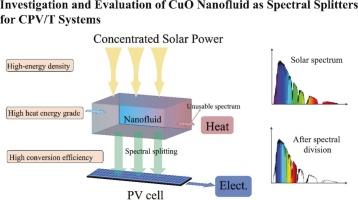Investigation of CuO nanofluid as spectral splitters for concentrated Photovoltaic/Thermal systems
IF 6
2区 工程技术
Q2 ENERGY & FUELS
引用次数: 0
Abstract
Concentrated Photovoltaic/Thermal (CPV/T) systems offer a synergistic approach to solar energy utilization through spectral splitting technology and integrated energy harvesting of high-flux solar radiation. To address the high-temperature operational demands of CPV/T systems, this study employs copper oxide (CuO) nanofluids with superior chemical stability as the spectral splitter. The optical transmittance of CuO was calculated with an optical model governed by the Lambert-Beer law, showing CuO nanofluids exhibited strong absorption capabilities below 700 nm and high transmittance in the 700–1100 nm wavelength range, which matches with monocrystalline silicon cells to serve as the spectral splitters. A comprehensive experimental framework was developed to evaluate system performance through critical parameters including exergy efficiency and merit function (MF). Experimental results under non-concentrated conditions revealed optimal performance at 300 ppm concentration for CuO nanoparticles, yielding a MF of 2.174 with thermal and electric power densities of 662.77 W/m2 and 66.50 W/m2 respectively. The integration of optical concentration technology demonstrated substantial performance enhancements. At a concentration ratio of 4, a high MF value of 1.878 was achieved and the system exergy efficiency was increased by 44.3 % compared to non-concentrated operation, accompanied by elevated thermal and electrical power densities of 1,859.11 W/m2 and 185.70 W/m2, which can provide simultaneous electricity and thermal output to satisfy medium-to-high temperature heating demands.

CuO纳米流体作为聚光光伏/热系统分光器的研究
聚光光伏/热(CPV/T)系统通过分光技术和高通量太阳辐射的综合能量收集,为太阳能利用提供了一种协同方法。为了满足CPV/T系统的高温操作需求,本研究采用具有优异化学稳定性的氧化铜(CuO)纳米流体作为光谱分离器。利用Lambert-Beer定律的光学模型计算了CuO的透光率,结果表明,CuO纳米流体在700 nm以下具有较强的吸收能力,在700 - 1100 nm波长范围内具有较高的透光率,与单晶硅电池作为分光器相匹配。开发了一个综合的实验框架,通过包括火用效率和功绩函数(MF)在内的关键参数来评估系统性能。非浓缩条件下的实验结果表明,在浓度为300 ppm时,CuO纳米颗粒的最佳性能为MF为2.174,热功率密度为662.77 W/m2,电功率密度为66.50 W/m2。光学浓缩技术的集成显示了显著的性能增强。当集中比为4时,系统的MF值高达1.878,系统的火用效率比非集中运行时提高了44.3%,热电功率密度分别达到1859.11 W/m2和185.70 W/m2,可以同时提供电、热输出,满足中高温供热需求。
本文章由计算机程序翻译,如有差异,请以英文原文为准。
求助全文
约1分钟内获得全文
求助全文
来源期刊

Solar Energy
工程技术-能源与燃料
CiteScore
13.90
自引率
9.00%
发文量
0
审稿时长
47 days
期刊介绍:
Solar Energy welcomes manuscripts presenting information not previously published in journals on any aspect of solar energy research, development, application, measurement or policy. The term "solar energy" in this context includes the indirect uses such as wind energy and biomass
 求助内容:
求助内容: 应助结果提醒方式:
应助结果提醒方式:


